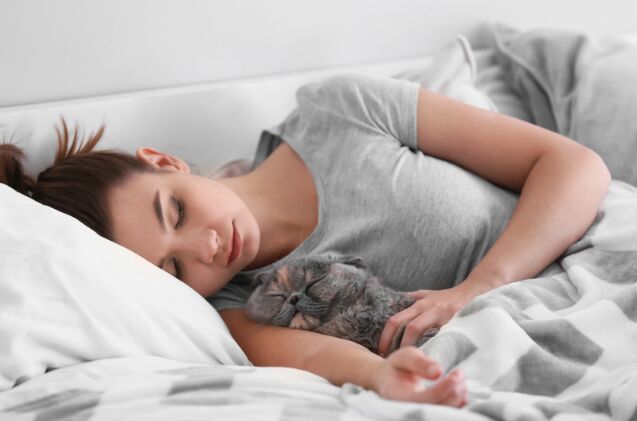Should My Cat Sleep in My Bed?

As cat parents, the bond we share with our furry friends is heartwarming and special. This often leads us to find many ways to keep our cats by our side – including inviting them to snuggle close at night. However, as new information emerges about the impact this could have on our sleep and our health in general, many cat lovers are now asking, “Should my cat sleep in my bed?”
It’s an important question we aim to answer in this blog post. Let’s dig into the pros and cons of sharing your bed with your cat to help you make an informed decision.
Do Cats Get Lonely at Night?
One of the biggest concerns many cat parents have when considering making the bed, or the bedroom, off limits is whether their cats will be lonely at night. There is no “one-size-fits-all” answer. Instead, this will vary depending on your cat’s personality and whether you have other cats in the home.
Pay careful attention to your cat’s behavior if you are concerned or unsure. Watch for signs of loneliness like being overly vocal, demanding attention or following you around anytime you get up to go to the bathroom, or engaging in “unwanted” behaviors like scratching your furniture, knocking items over, or having accidents outside the litterbox.
Do Cats Like to Sleep with Their Owners?
Like the question of whether your cat will be lonely at night, this will vary from cat to cat. Some cats love curling up with their people in bed, while others are more independent. The best way to find out if your cat does (or doesn’t) like to sleep curled up with you is to give them the opportunity. But don’t force it! Give them a chance to decide if they want some snuggle time to learn your cat’s preferences.
How to Decide Whether to Let Your Cat Sleep in Your Bed
Of course, deciding whether to allow your cat to sleep in your bed will depend on more than your cat’s preferences. You also need to determine if it will work for you, too! After all, your health and well-being are important as well. Here are a few factors to consider when trying to reach the right arrangement for you and your cat:
Benefits of Sharing Your Bed with a Cat
First, let’s look at the positive side – what benefits can you enjoy by allowing your cat to sleep in your bed? You may be surprised to learn a few of these…
A Furry Heating Pad
Do you generally feel cold at night? Have you considered investing in a heated blanket or mattress pad? One budget-friendly solution is to let your cat curl in close while you’re sleeping. They may be small, but you will be surprised by how much heat a cat can produce – I know I often am with our two!
If you’re dealing with an injury or ailment, they may be able to soothe any pain you’re feeling. Our pets are often highly in tune with our needs and discomforts. You may find that your cat gravitates to lying against the area of concern. This can work similarly to a heating pad or hot water bottle, helping to increase blood flow, relax stiffness, and relieve pain.
Purrs are Healing
Have you ever felt calmer or more relaxed when your cat started purring? Research shows that this is more than just the happiness of knowing your cat is that content. The frequency of a domestic cat's purr is said to have healing properties, providing a therapeutic benefit for pain, edema, and other conditions. If you’re struggling to sleep due to chronic pain, arthritis, or an injury, curling up with your cat may be the perfect solution!
For those not currently battling pain and discomfort, don’t count out the power of purring. It has also been found to act much like a white noise machine, helping to calm your mind and lull you into a deep, relaxed sleep.
Find Comfort in a Heartbeat
Another calming sensation often seen with babies and young children is the soothing effect of a heartbeat. Consider the young baby that struggles to fall asleep until they are held close, head resting on their mother’s chest and falling asleep to her heartbeat. It’s also why products like Calmeroos Heartbeat Toys are so comforting for young puppies and kittens.
If you’re struggling with falling asleep or suffering from insomnia, this may be exactly what you need! Let your cat cuddle in, close your eyes, and focus on their heartbeat. Some say it’s more effective than counting sheep!
Quality Time
Of course, the obvious benefit of letting your cat sleep in your bed is being close to your furry best friend. If you’re entertaining this question, I would hazard a guess that you view your cat as a family member, much like I consider my own. This means you enjoy spending as much time together as possible, even if you’re both fast asleep. Your bond with your cat is special; this is just another opportunity to embrace that.
Disadvantages of Welcoming Your Cat into Your Bed
Of course, inviting a pet to crash in your bed isn’t all sunshine and rainbows. There are also some potential disadvantages to consider, especially if they will negatively impact your sleep and, in a roundabout way, your well-being. Here are a few reasons you may want to set a “humans only” rule in your bed:
Allergies, Dust & Dander
Do you suffer from allergies? If so, having your cat in the bed may harm your health. While we all want to spend time with our cats, your health and well-being are top priorities. This is especially important if you have asthma or any other respiratory that could be aggravated by sleeping with your cat close.
This isn’t to say that it’s 110% off the table. If you’re still interested in exploring your options, talk to your doctor and your cat’s veterinarian. There are specialty foods that can help reduce the risk of allergies. You may also be able to take medication to reduce the effects or start allergy shots.
Concerns About Parasites and Disease
I would be lying if I said that there was no possible chance of your cat getting you sick. Some illnesses and ailments can be transmitted from pets to their owners. Additionally, many parasites, like fleas and ticks, can be transferred.
The Centers for Disease Control and Prevention (CDC) warns about the following diseases that can be transmitted from cats to people:
- Campylobacteriosis
- Cat Scratch Disease (which can also be transferred with a lick)
- Cat Tapeworm
- Cryptosporidiosis
- Giardiasis
- Hookworm
- MRSA
- Plague
- Rabies
- Ringworm
- Roundworms
- Salmonellosis
- Sporotrichosis
- Tickborne Diseases (Lyme Disease, Tularemia, Ehrlichiosis, Babesiosis)
- Toxoplasmosis
- Tularemia
Some of the illnesses listed, while possible to be transmitted, obviously aren’t a serious risk. But some of these are a legitimate concern, especially for those who are more vulnerable, like seniors, young children, and those with a compromised immune system.
If your cat is ever showing signs of illness, keeping them out of your bedroom until they have recovered is recommended. This includes when you are treating them for a flea infestation or other parasitic infection. If you are unsure whether it is too early to bring your cat into your bed following treatment, consult your veterinarian.
Nighttime Escapades
Many cats share a more nocturnal schedule, running and playing by night and sleeping the day away. If your cat falls into this category, allowing your cat into the bedroom could be problematic. Picture curling up in your bed, all cozy and ready for sleep, only to have your furry friend running across the bed or pouncing at your feet. It’s certainly not a recipe for a restful night!
If you know that your cat isn’t going to settle in with you for the night, it may be best to keep the door closed and let them have the rest of the house for their playground.
6 Cozy Places for Your Cat to Sleep if the Bed is Off-Limits
Don't feel guilty if you are concerned that your cat may hinder your ability to sleep at night. Many cat parents have concluded that the best decision for everyone involved is to keep their cat out of the room at night – and that’s okay! Even if your cat’s schedule lines up with yours and they are sleeping simultaneously, there are many other great options available to provide them with a comfortable place to rest.
Cat Beds
The first and most obvious alternative is to provide your cat with their own cat bed. Many sizes and styles are available, allowing you to select the best fit for your kitty. Take note of your cat’s sleep style and what this may reveal about their ideal bed.
For example, a cat that likes to burrow into your lap or a fuzzy blanket may be most comfortable in a bed like the Winsterch Covered Cat Cave Bed, where they can snuggle under the covers. Meanwhile, a cat that usually sprawls out when sleeping may be happier in a mat-style bed like the MidWest Homes Plush Pet Bed.
Heated Cat Beds
A heated cat bed is a special type of cat bed that your cat may love, especially during the cold winter months. Like a human heating pad, they often offer multiple temperatures. The K&H Pet Products Thermo-Kitty Bed is automatically controlled based on your cat’s body temperature, offering minimal heat when your cat isn’t present. This helps to make the bed more efficient.
Kitty Condos
Many cats find comfort in enclosed areas. This allows them to feel safe and secure, hidden away from the potential predators and threats in the area. A kitty condo like the Bedsure Large Cat Cave is an excellent solution for cats like this. This box-shaped bed allows your cat to snuggle in out of sight, and the enclosed design works well to keep your cat warm by trapping their body heat inside. Kitty condos are our oldest cat, Pippen’s bed of choice!
Cat Trees and Furniture
Cat trees and other cat furniture often incorporate several places for your cat to take a cozy nap, including platform-style beds, built-in condos, hammocks, and more. When selecting the perfect cat tree for your cat’s needs, there are several factors to consider, including:
- Size
- Material
- Style
- Color
- Budget
- Added Features
Cat Hammocks
An often-overlooked style of cat bed is the hammock. As the name suggests, these beds are constructed with suspended fabric to create a comfortable place to sleep. They are available as a free-standing cat bed, like the Ivrydas Cat Hammock Bed, a wall-mounted bed, like the 7 Ruby Road Wall-Mounted Cat Hammock, or a window perch, like the K&H Pet Products Deluxe EZ Mount Kitty Sill Cat Window Perch.
Create a Cozy “Nest” with Blankets
For some cats, you can buy all the fancy beds and furniture in the world, and they will still gravitate to sleeping on the couch or their favorite chair. If this is the case, don’t fight it. Rather than spending money on a special bed, consider purchasing a dedicated blanket or two and setting up a place to sleep where they tell you they want to be most.
Final Thoughts - Should My Cat Sleep in My Bed?
There is no “right” answer as to whether your cat should be allowed to sleep in your bed. While your furry friend could provide comfort and warmth through those long nights, they may also trigger health problems or keep you awake.
Cat parents need to weigh the pros and cons, consider their cat’s personality and sleeping habits, factor in their own needs, and decide on the best solution for everyone. If you need your own space at night for a restful night’s sleep, there are other options that you can provide, including heated cat beds, cozy condos, and relaxing hammocks. Whatever you decide, the ultimate goal is to set up your home so everyone can get the sleep they need to live a happy, healthy life!
Join the PetGuide community. Get the latest pet news and product recommendations by subscribing to our newsletter here.

Britt Kascjak is a proud pet mom, sharing her heart (and her home) with her “pack” which includes her husband John, their 2 dogs – Indiana and Lucifer – and their 2 cats – Pippen and Jinx. She has been active in the animal rescue community for over 15 years, volunteering, fostering and advocating for organizations across Canada and the US. In her free time, she enjoys traveling around the country camping, hiking, and canoeing with her pets.
More by Britt
























